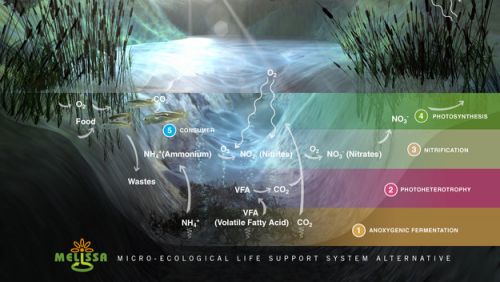
03/09/2015
Travelling to Mars Is In Progress Near the Barcelona Synchrotron Park
Travelling to Mars Is In Progress Near the Barcelona Synchrotron Park
Recently, an original experiment carried out on the International Space Station was exposed by the media: astronauts tested in August the first vegetable ever cultivated into space (a salad) as part of a NASA experiment to help prolong manned missions.
Some hundred meters horizontally far from the Barcelona Synchrotron Park (BSP) - and not 400 km above it -, the MELiSSA pilot plant from the European Space Agency (ESA), which is located in the engineering school of the Universitat Autònoma de Barcelona (UAB), the BSP strategic partner, works on a similar but much more ambitious project.
During a round-trip voyage to Mars, a six-person crew would need about 30 tons of food, oxygen and water for the 1,000 days mission. This huge quantity would be drastically reduced if a closed loop system would recycle the CO2 exhaled and the waste produced by the crew in order to produce in return oxygen, water and food, etc.: this is the MELiSSA project.
This project started 20 years ago and is founded up to 60% by the ESA (5 million Euros per year). It involves 100 researchers from 30 organizations and 15 European countries. In this puzzle the UAB pilot plant, which was inaugurated in 2009, plays a central role and will soon take a new important step: living beings will be introduced in the plant in order to test some parts of the artificial ecosystem. Rats, not astronauts, at the moment.
http://www.esa.int/Our_Activities/Space_Engineering_Technology/Melissa
Some hundred meters horizontally far from the Barcelona Synchrotron Park (BSP) - and not 400 km above it -, the MELiSSA pilot plant from the European Space Agency (ESA), which is located in the engineering school of the Universitat Autònoma de Barcelona (UAB), the BSP strategic partner, works on a similar but much more ambitious project.
During a round-trip voyage to Mars, a six-person crew would need about 30 tons of food, oxygen and water for the 1,000 days mission. This huge quantity would be drastically reduced if a closed loop system would recycle the CO2 exhaled and the waste produced by the crew in order to produce in return oxygen, water and food, etc.: this is the MELiSSA project.
This project started 20 years ago and is founded up to 60% by the ESA (5 million Euros per year). It involves 100 researchers from 30 organizations and 15 European countries. In this puzzle the UAB pilot plant, which was inaugurated in 2009, plays a central role and will soon take a new important step: living beings will be introduced in the plant in order to test some parts of the artificial ecosystem. Rats, not astronauts, at the moment.
http://www.esa.int/Our_Activities/Space_Engineering_Technology/Melissa
More news
13/04/2023
Panattoni acquires 60,000 sqm land plot to build a data center
16/09/2021
Battery technology in the Barcelona Synchrotron Park environment
06/09/2021
Advances in the creation of a state-of-the-art microscopy platform at the Alba Synchrotron
22/07/2021
IBM, the big blue of technology at the Barcelona Synchrotron Park
02/07/2021
SENER, cutting-edge engineering and technology in the Barcelona Synchrotron Park
11/06/2021
Parc de l'Alba: first injection of landfill gas into the distribution network









